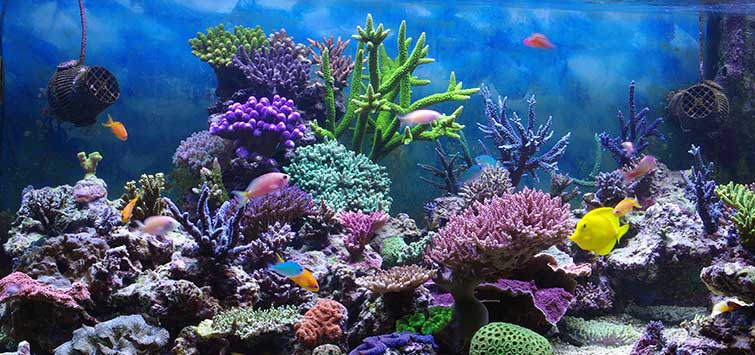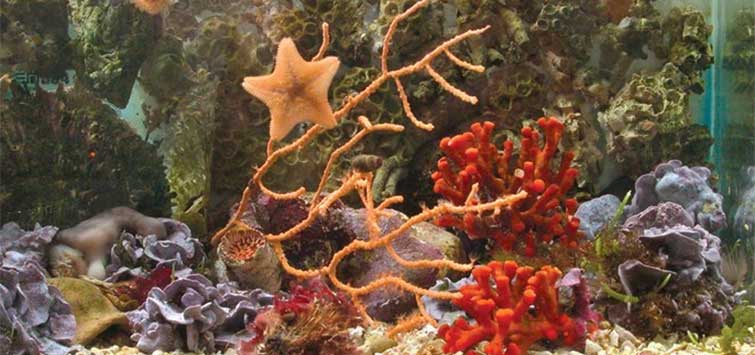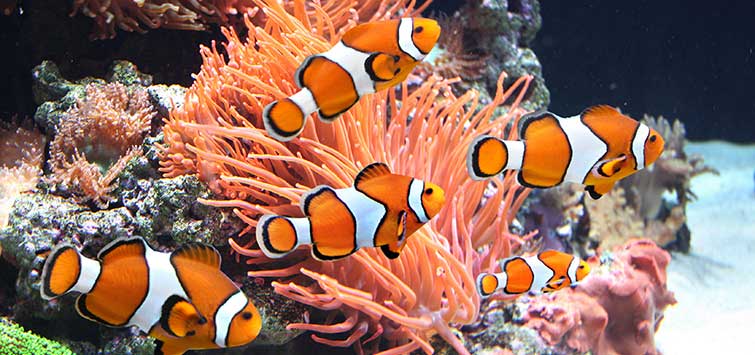Getting Started in the Reef Aquarium Hobby
Author: James W. Fatherree
Adding corals may be an intimidating endeavor, but our resident reefer breaks the process down so even novice fishkeepers can take on the challenge of keeping their own little patch of coral reef.
If you already have a marine fish-only system or are completely new to the marine aquarium hobby and want to jump right into reefs, there are obviously quite a few things to learn before you begin. A reef aquarium is by no means just a regular saltwater aquarium with some corals added in.
For one thing, you’ll have to pay much more attention to water quality than when dealing only with fish. You will also have to provide substantially more lighting as well as strong circulation, and providing foods suitable for corals can often make a big difference in how successful you are. I’d like to go over some basics here in order to give you an idea of what’s required to keep corals alive and healthy. While the details of setting up a reef aquarium and long-term maintenance can (and does) fill whole books, this should be enough to get you thinking and headed in the right direction.
Water Quality
Regardless of the type of aquarium you have or intend to set up, maintaining water quality is of the utmost importance. This includes such things as keeping the salinity, temperature, pH, and other parameters within acceptable ranges, which is vital to the survival of livestock.
As mentioned, this is especially important if you want to keep living corals, as it will be absolutely imperative that you keep the water in an aquarium close enough in character to natural seawater to keep them alive and well. Mixing up some synthetic sea salt and water is definitely just the very beginning of water quality maintenance when it comes to reef aquariums.
Salinity
Maintaining an appropriate salinity means the water in a reef aquarium must contain an appropriate amount of dissolved salt, which means you must make sure that the right amount of synthetic salt mix is used when making up new seawater. This is typically checked by testing the density of the water, as it becomes increasingly dense as more salt mix is added.
To do this, you’ll need a hydrometer (a device that measures the water density) of some sort to test the salinity and make sure it stays in the ideal range of 1.023 to 1.027. If it gets too far above or below this range, any corals in the tank will die no matter how perfect everything else may be. The same can also be said for many other aspects of water quality, for that matter.
Temperature
When it comes to temperature, you’ll have to make sure the water stays in the 72° to 84°F range and doesn’t change much from day to day or day to night. While temperatures may get a little higher or lower than this in reef environments, many corals will die if temperatures rise or fall a few degrees over or under this range; in fact, you’re even taking chances by letting temperatures reach either end of the suggested maximum range, so this is best avoided.
The optimal range is actually somewhere around 75° to 81°F, which is what you should really try for, as this range is perfectly suitable for corals. Temperatures around reefs also change very slowly, typically over periods of weeks or even months, and usually not very much from daytime to nighttime. Stability is important for keeping corals.
Nitrogenous Compounds
Fishes and other organisms in aquariums give off ammonia as a waste product, and it’s also produced by the decay of uneaten foods. It’s deadly to most organisms, even at low concentrations, so you will need enough live rock and/or live sand to be sure that your aquarium has adequate biofiltration—sufficient bacterial colonies that have the unique ability to use the ammonia as food.
This bacteria-based filtration can keep the concentration of ammonia at zero (or at least very close to that) via the metabolic activities of microorganisms that occur naturally in porous rocks and sand.
Millions upon millions of different bacteria live in such places and will suck ammonia right out of the water about as fast as it is produced. It’s then converted to nitrite, which is then converted to relatively benign nitrate by yet another suite of beneficial bacteria, and the nitrate can then be removed in various ways such as regular water changes. This entails simply removing some of the old water from the aquarium and replacing it with new seawater made up with quality synthetic sea salt and filtered water.
Calcium and pH
The concentration of calcium, the pH, and the alkalinity of the aquarium’s water are particularly important for corals, too, especially those that produce hard skeletons. Thus, all three of these must be maintained at acceptable levels. Corals use calcium from seawater to produce their calcium carbonate skeletons or skeletal components, so you’ll have to make sure they have access to plenty of calcium if you expect them to stay healthy and to grow. Coral health and skeletal growth are also strongly affected by the water’s pH, and the pH is strongly affected by the water’s alkalinity.
Alkalinity is the ability (or lack of ability) of your aquarium water to resist notable changes in pH from day to night and day to day, which are unwanted because you must strive for stability. Each of these can be controlled through various means that you should research.
Keeping calcium concentrations in the range of 400 to 450 ppm is optimal, but they can be a bit lower or higher. The pH should optimally be kept around 8.2 to 8.4, and alkalinity should be kept in the range of 7 to 12 dKH, though these may often go a little higher or lower. There are several ways to accomplish all of this without too much trouble, though. You can choose from using limewater (typically called kalkwasser) or two-part liquid additives, or even a specialized device called a calcium reactor. Every method has its own pros and cons, so you’ll need to do some homework and decide which one best suits your budget and schedule.
Nutrients
And lastly (with respect to water quality), you’ll also need to keep waterborne nutrients, particularly phosphorus, at minimal levels. Most corals come from areas where nutrients are available in the form of plankton and other particulate foods, but not dissolved in the water itself. Therefore, the concentration of dissolved nutrients on reefs, including various phosphates, is very low. As with the factors covered above, the presence of phosphates can also affect the production of calcium carbonate skeletal material by stony corals, and elevated phosphate levels can shut down its production completely.
In addition, phosphates also act as great fertilizers, but for all the wrong things. Elevated phosphate concentrations can quickly lead to the rapid growth of unwanted algae, which can really muck up an aquarium and even overgrow and kill corals.
Avoid overfeeding your fishes, corals, and other livestock, as fish foods are the primary source for phosphates. You’ll also need to perform regular water changes, use a specialized filter called a protein skimmer, and harvest and remove algae as fast as it grows in the aquarium. And again, there are various options at your disposal, each of which has its own pros and cons—you’ll have to decide which is best for you.
Lighting
Almost every coral available to hobbyists will require lighting of higher quality and intensity than what is used over fish-only tanks. This is due to the fact that they have a population of symbiotic single-celled algae living inside their bodies, and these algae require the right light in the right amount in order to stay alive and keep their host coral alive. You’ll need a powerful lighting system with bulbs designed for this purpose.
The four basic types of reef aquarium lighting systems utilize VHO (very high output) fluorescent bulbs, PC (power compact) fluorescent bulbs, T-5 fluorescent bulbs, or MH (metal halide) bulbs, and many systems use some combination of these.Various systems also have different numbers and arrangements of bulbs.
Different types of symbiotic corals will need different amounts of light, as some can live under relatively low-intensity illumination while others need high-intensity illumination. However, even the corals that can withstand low light levels still require hefty lighting. Of course, the same sort of setup might be considered moderate in intensity over a much shallower tank (like a 30-gallon), but totally unacceptable over a much wider/deeper tank (like a 150-gallon). This is because light intensity drops very quickly with increasing distance from the bulbs and with increasing water depth.
Likewise, four VHO or PC bulbs over a 55-gallon tank could be considered moderate intensity but high intensity over a smaller tank and low intensity over a wider/deeper tank. Get the idea? Your requirements will ultimately depend on the tank size/depth and what types of corals you intend to keep.
Circulation/Current
Corals are animals and require oxygen to stay alive, but unlike fishes and such, they lack any sort of gills or blood and rely on the absorption of oxygen directly from the water to survive. This means they’ll need a constant supply of oxygenated seawater, which is brought to them by currents. They also rely on currents to bring them food, to keep sediment from settling on top of them and smothering them, and to blow away any wastes they may give off. Water movement is therefore very important in reef aquariums.
Some species of coral need much more or much less current than others, but in general they all require considerably more water motion than what is seen in typical non-reef aquariums. Fish aquariums may have nothing more than a couple of air stones to create currents, and/or some sort of power filter hanging off the back, but in a reef aquarium you’ll need to use pumps of some sort to keep the water churning and to produce turbulent currents.
In general, more than one pump is used, and these pumps should be positioned in such a way that their effluent streams intersect and create mixing currents that move around the tank, rather than always blowing a linear stream at a single point in the tank. You can also buy electronic devices that act like timers, switching different pumps on and off in sequences that create mixing currents, or you could get even fancier and use a surge device that periodically dumps water into the aquarium to create larger waves.
Feeding
Corals may occasionally capture a bit of fish food or some of the sparse plankton that can be found in healthy reef aquariums, and many hobbyists provide little or nothing else for their corals. However, providing food specifically for corals can certainly improve your chances of keeping them healthy and growing. There are three basic ways to do this—you can hand-feed them, you can add some sort of store-bought plankton substitute product, and/or you can set up your aquarium in a way that provides them with natural foods generated in a deep bed of sand within the tank itself or in a refugium.
Many corals, those with large mouths and/or feeding tentacles in particular, can actually be given food by hand. If provided, they’ll eat small-sized meaty foods such as bits of squid, crab, shrimp, clams, etc., and big corals can even take small fishes. They’ll also take smaller items like brine shrimp and bloodworms.The easiest way to feed the smaller foods is to find a big syringe without a needle at a local drugstore and then fill it with some food and tank water. You can then direct a little squirt of food-laden water at a coral and let it capture the bits. If the end of the syringe happens to be too small in diameter to work with, you can always clip it down with some scissors to make the opening bigger. Also note that it’s a good idea to turn off all the pumps when you do this so the bits aren’t blown away too quickly.
If you try this, you’ll find that any coral with relatively large tentacles will quickly grab anything you squirt into them with your syringe, but many other animals will grab the food as well. Anemones, mushroom corals, button polyps, and even corals that have small tentacles will take what they can get when the opportunity arises. However, there are some exceptions, and it’s typically a matter of trial and error figuring out what foods a given coral will accept.
Likewise, you should occasionally provide other types of corals, those with small tentacles and mouths, with some sort of fine particulate food. Many such corals capture plankton of various sorts and sizes, and there are a number of products you can use to provide them with the real thing or a suitable substitute.Or, if you want to provide your corals with a supply of live foods generated within the aquarium, you can set up the tank with a deep sand bed (DSB) that is full of organisms. This entails using at least 2 or 3 inches of fine aragonite sand to fill the bottom of the tank, and then stocking the sand with various sand-dwelling critters.
The organisms that live in the sand bed can become a food source for your corals, but more importantly they can also produce eggs, larvae, etc., which are released into the water and can be captured and eaten by various corals. Another way to provide live foods is to add a refugium, which is basically a tank that is plumbed to (but separated from) the main tank, where live foods such as macroalgae and zooplankton can be cultured.
Summary
While this short article only provides a short overview, it’s clear that the successful caring for corals takes considerable know-how, equipment/supplies, and attention. Nevertheless, a reef aquarium can definitely be well worth the money and time spent when it comes to enjoyment—so long as you do things right. Do your homework, find out as much as you can about the various points I’ve brought up, and get started the right way if you choose to get into reef aquariums.
See the full article on TFH Digital http://www.tfhdigital.com/tfh/20101/#pg85

.png?h=595&iar=0&w=2781&hash=5FD5E69473BCC22199FBFA2FB71B6033)



